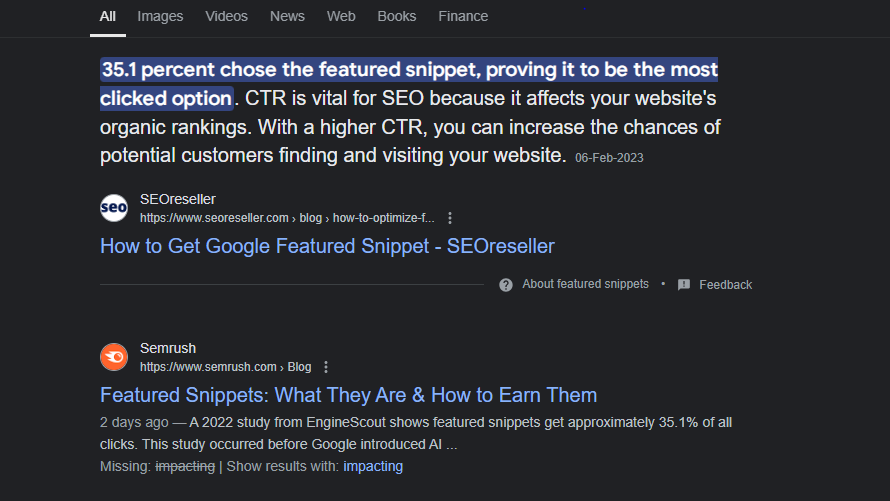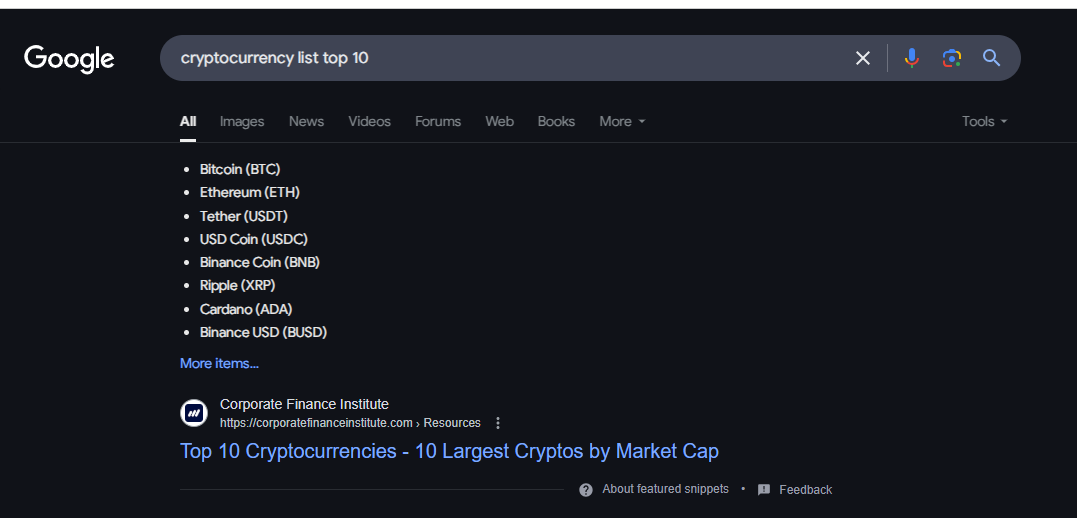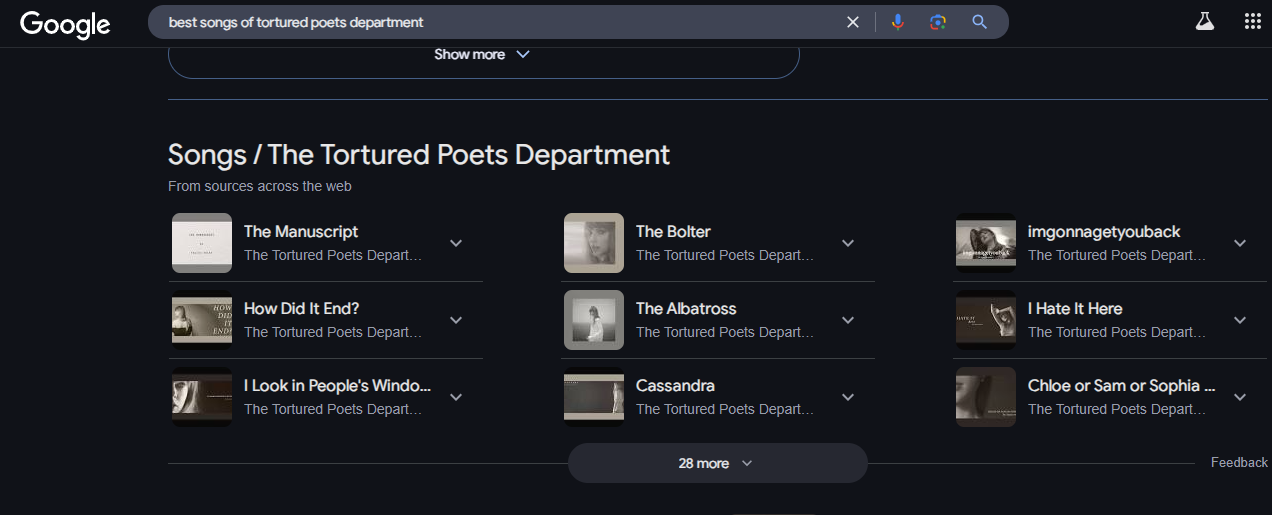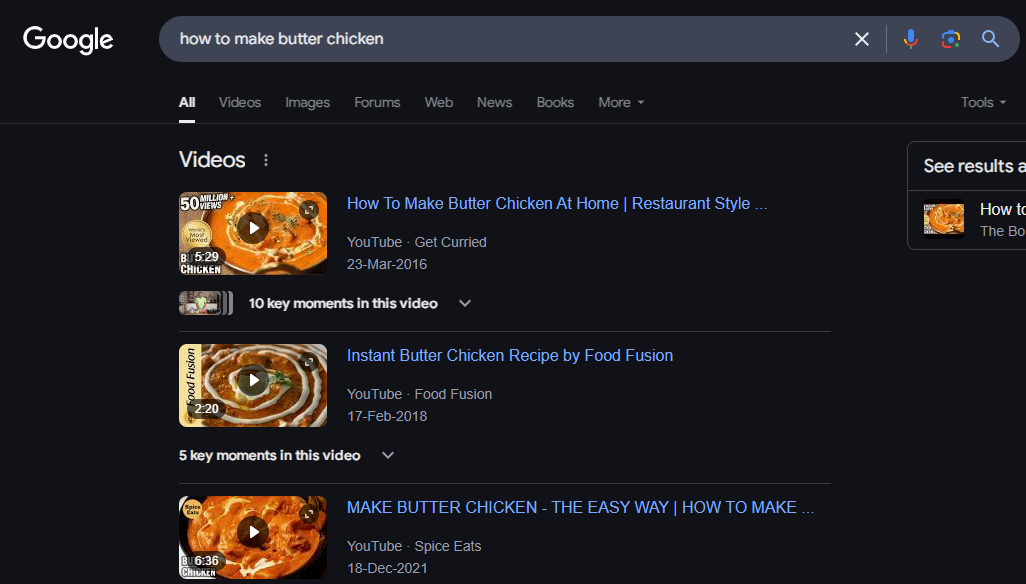- Featured snippets, also known as “Position Zero,” are concise answers that appear at the top of Google’s search results.
- They are crucial for SEO as they can significantly increase a website’s credibility and organic traffic.
- The four main types of featured snippets are paragraph, list, table, and video snippets.
- To optimize for snippets, directly answer user queries, target long-tail keywords, and structure content with clear headings and short paragraphs.
- Advanced tips include leveraging the “People Also Ask” section, multimedia integration, and voice and mobile optimization.
Ever noticed how some websites instantly grab your attention on Google?
That’s often thanks to featured snippets—the quick, concise answers that pop up at the very top of search results.
Featured snippets have so much to offer. In fact, research shows that featured snippets gather 42% of total click shares over regular search listings.
This means, if your website ranks at position zero, you can expect visitors and more credibility, all from that prime real estate on the search page.
In a world where users demand fast, clear answers, featured snippets deliver just that.
They help you connect with your audience immediately, making your site a go-to resource.
Ready to see how this can work for you?
Let’s elaborate more!
Be the Answer, Not Just an Option!
We optimize your site for top rankings, so customers find YOU first. Get started with Nexa Growth today!
Contact UsWhat Are Featured Snippets?
Users want an instant answer right at the top of their search results. That’s what featured snippets do—they serve up bite-sized answers that cut through the clutter.
When you search on Google, sometimes you see a special box with a quick response pulled from a website. That’s a featured snippet.
Google selects the most relevant content and showcases it, so you don’t have to click through multiple links.
There are several types of featured snippets. You might see:
- Paragraph Snippets: A short, clear text answer.

An Example of a Paragraph Featured Snippet - List Snippets: Bullet points that break down steps or ideas.

An Example of a List Snippet - Table Snippets: Organized data that makes comparisons easy.

An Example of a Table Snippet - Video Snippets: Quick visual guides that answer how-to queries.

An Example of a Video Snippet
Studies show that landing a featured snippet can boost your organic traffic by around 20%. That’s a serious win for your SEO efforts.
It’s all about giving users the quick, precise information they need—when they need it.
They position your content as the go-to answer, build trust with your audience, and can even help you stand out from competitors.
By aiming to secure this prime spot, you’re setting the stage for higher visibility and increased engagement.
Featured Article: The Importance of Title Tags and How to Optimize Them
Why Featured Snippets Matter for SEO
When your content gets featured, it’s like having a spotlight on your website.
Your answer pops up at the very top of Google, even before the first organic result. That kind of prime visibility builds instant trust with your audience.
Landing a featured snippet can give your traffic a serious boost. More clicks mean more opportunities to engage your visitors and turn them into loyal readers or customers.
Featured snippets also give you a competitive edge.
In a crowded digital space, standing out with that coveted snippet can position your site as the go-to source. It’s not just about being seen—it’s about being seen as the expert.
Overall, featured snippets are a powerful asset in your SEO strategy. They help you capture attention, drive traffic, and build authority—all essential ingredients for online success.
Types of Featured Snippets
As discussed earlier, there are four types of featured snippets, including:
- Paragraph Snippets: These are the most common type, offering a brief text-based answer in just a few lines. They work best for straightforward questions that need a quick explanation, giving users an instant answer without any extra fluff.
- List Snippets: These break down information into clear bullet points or numbered steps. This format is ideal for how-to queries or questions that require step-by-step guidance. A well-organized list makes complex information much easier to digest.
- Table Snippets: These display data in a neat grid-like format, making them perfect for comparisons or detailed statistical data. The clarity and visual appeal of tables can simplify complex information, helping users quickly find what they need.
- Video Snippets: These add a dynamic element to your content. They’re especially useful for tutorials and demonstrations where visual guidance enhances understanding. With clear titles and descriptions, video content can capture attention and secure that prime spot in search results.
Featured Article: What Is On-Page SEO? A Beginner’s Guide for 2026
How to Identify Featured Snippet Opportunities
Optimizing for featured snippets is all about anticipating what users are asking and delivering clear, concise answers right away.
Think of it as answering a friend’s question over coffee—get straight to the point and keep it simple.
Start by answering questions directly.
Instead of burying the answer in lengthy paragraphs, highlight it at the top of your content. When Google sees that you’re providing an immediate, straightforward response, it’s more likely to pick your page for that prime spot.
Next, target long-tail keywords. These are more specific phrases that users search for when they’re looking for detailed answers.
Focusing on these not only makes your content more relevant but also increases your chances of capturing niche queries that often trigger featured snippets.
It’s also important to structure your content effectively. Use clear headings, bullet points, and short paragraphs to break up the text.
A well-organized page helps both your readers and search engines quickly grasp your key points.
Finally, consider the People Also Ask section.
These related questions offer extra opportunities to rank for similar queries. By including concise answers to these common questions, you can capture even more visibility and drive additional traffic.
Each of these strategies works together to make your content more appealing for featured snippets, helping you stand out in the competitive search landscape.
Clicks, Conversions, and a Competitive Edge!
Our SEO strategies don’t just bring traffic—they bring results. Partner with Nexa Growth now!
Contact UsHow to Optimize Your Content for Featured Snippets
Here are some tips to help you optimize for featured snippets:
-
Answering User Queries Directly
To capture a featured snippet, your content must immediately address the user’s query with clarity and precision.
Begin by summarizing the answer at the top of your section, using simple language that directly tackles the question.
This concise answer should be free of fluff and provide a clear response that both users and search engines can quickly digest.
For instance, if the query asks “What is a featured snippet?”, start with a direct definition followed by a brief explanation.
Highlighting or bolding this summary can further draw attention and signal its importance to search engines.
-
Targeting Long-Tail Keywords
Long-tail keywords represent more specific user queries, often reflecting detailed questions that are easier for your content to answer.
Integrate these keywords naturally throughout your article, especially in your headings and opening paragraphs.
This approach not only aligns your content with user intent but also increases the likelihood of matching a nuanced query in a featured snippet.
Performing thorough keyword research to uncover these long-tail variations ensures your content addresses the precise questions that lead to snippet selection.
-
Structuring Your Content
A well-organized page enhances both user experience and snippet eligibility. Break your content into clearly defined sections using H1, H2, and H3 headers, which helps search engines understand the hierarchy and main points of your content.
Utilize bullet points, numbered lists, and tables where appropriate, as these formats are easily extracted for featured snippets.
Each section should have a clear purpose, allowing search engines to pinpoint the exact answer they need to display.
A logical structure not only makes your page more navigable but also increases the chances of being selected for a featured snippet.
-
Leveraging “People Also Ask” Insights
Incorporate common questions from the “People Also Ask” section into your content. By addressing these related queries, you build a more comprehensive resource that covers multiple facets of the topic.
This strategy can boost your content’s authority and relevance, as search engines favor pages that thoroughly answer users’ diverse questions.
Seamlessly weave these additional questions and answers into your narrative to further enhance snippet potential.
-
Enhancing with Visuals and Data
Complement your textual content with relevant visuals like images, charts, or infographics. Visual aids can clarify complex information and break up lengthy text, making your content more engaging.
Additionally, well-designed visuals often provide quick answers to data-driven queries, increasing the likelihood of your page being chosen as a featured snippet.
By combining direct answers, strategic keyword targeting, structured formatting, and supportive visuals, your content becomes highly optimized for featured snippet selection.
Featured Article: How Long Does SEO Take to Show Results? A Realistic Timeline
Tools and Strategies for Tracking Featured Snippet Performance
Monitoring your featured snippet rankings is crucial for refining your SEO strategy and understanding what works best.
Start by integrating robust SEO tools like Semrush, Ahrefs, or Moz, which can help track your snippet positions alongside your organic rankings.
These platforms offer detailed insights, such as changes in rankings, click-through rates, and even the impact of your snippet on overall traffic.
Another effective strategy is setting up Google Search Console reports. This free tool provides valuable data on the search queries that lead to impressions and clicks, helping you pinpoint which queries trigger featured snippets.
Regularly review these insights to identify trends and adjust your content accordingly.
Additionally, consider periodic manual checks of your target keywords on various devices and locations to ensure your snippet performance remains consistent.
By combining automated tracking with manual verifications, you can maintain an agile approach that adapts to evolving search engine algorithms and user behaviors.
Advanced Tips and Best Practices
Elevate your snippet strategy by incorporating advanced tactics that go beyond basic optimization.
These practices can provide a competitive edge and ensure your content remains dynamic and engaging.
- Multimedia Integration
- Leverage Videos and Infographics: Integrate relevant videos, charts, and infographics that succinctly answer questions and provide visual clarity.
- Interactive Content: Consider interactive elements such as quizzes or sliders to engage users and offer quick answers in an intuitive format.
- Voice Search and Mobile Optimization
- Voice-Friendly Content: Optimize your text for voice queries by using conversational language and natural phrasing.
- Mobile-Responsive Design: Ensure your content adapts seamlessly across devices with fast load times and a user-friendly interface.
- Schema Markup: Implement structured data to help search engines interpret your content accurately, especially for voice search.
- AI-Driven Content Optimization
- Data Analytics: Use AI tools to analyze user behavior and adjust your content strategy based on performance metrics.
- Content Personalization: Leverage machine learning to tailor content dynamically to user preferences.
- Continuous Improvement: Regularly update and refine your content based on predictive insights from AI algorithms.
Comparative Overview
| Best Practice | Key Focus | Recommended Tools/Strategies |
| Multimedia Integration | Visual and interactive content | YouTube, Canva, Adobe Creative Suite |
| Voice and Mobile Optimization | Conversational language and responsive design | Google AMP, Responsive Web Design, Schema Markup |
| AI-Driven Optimization | Data-driven content refinement | SEMrush, Ahrefs, Google Analytics, AI content platforms |
By adopting these advanced practices, you can maintain a robust and agile content strategy that not only targets featured snippets but also enhances the overall user experience and SEO performance.
Rank Higher, Grow Faster!
Let Nexa Growth perfect your SEO and put your brand in the spotlight.
Contact UsExamples of Different Industries and How They Can Optimize for Featured Snippets
Below are practical examples across various industries with tailored strategies to increase the likelihood of ranking in featured snippets:
-
Health and Wellness
- Strategy:
- Create comprehensive FAQs addressing common health concerns.
- Use bullet points or numbered lists to outline symptoms, treatments, or preventative tips.
- Incorporate structured data (schema markup) to help search engines parse medical information.
- Example Query: “What are the early signs of flu?”
- Provide a concise answer with clear, medically-reviewed points at the top of the content.
- Strategy:
-
Finance and Investment
- Strategy:
- Use tables and comparison charts to break down complex financial products (like credit cards, loans, or investment options).
- Offer clear definitions and step-by-step guides on financial concepts.
- Example Query: “How does compound interest work?”
- Include a simple explanation followed by a detailed table comparing different compounding periods.
- Strategy:
-
Technology and Software
- Strategy:
- Develop step-by-step tutorials for troubleshooting, software installations, or how-to guides.
- Utilize numbered lists and short, actionable bullet points that directly answer technical questions.
- Example Query: “How to reset a router?”
- Begin with a succinct list of steps, complemented by visuals or diagrams to illustrate each stage.
- Strategy:
-
Travel and Hospitality
- Strategy:
- Answer common travel queries with lists of top destinations, itinerary suggestions, or packing tips.
- Use maps, images, and comparison tables to enhance the content.
- Example Query: “Best travel tips for Europe on a budget”
- Offer a clear, bulleted list of tips with direct advice, followed by examples of budget-friendly destinations.
- Strategy:
-
E-commerce and Retail
- Strategy:
- Implement product comparison tables and review summaries for specific product categories.
- Answer common buying questions using clear bullet points or short paragraphs.
- Example Query: “What are the top features of the latest smartphones?”
- Provide a brief list highlighting key features and benefits, using visually distinct formatting to capture attention.
- Strategy:
-
Education and E-learning
- Strategy:
- Develop detailed guides or FAQs on topics such as online learning benefits, study tips, or course selection.
- Use bullet points and subheadings to break down complex educational content.
- Example Query: “Benefits of online learning vs. traditional education”
- Present a side-by-side comparison in bullet format or a table for quick reference.
- Strategy:
-
Real Estate
- Strategy:
- Offer data-driven content like property value assessments, market trends, or buying guides in structured formats.
- Utilize tables to compare neighborhood statistics, mortgage rates, or property features.
- Example Query: “How to determine the value of a property?”
- Start with a concise explanation followed by a detailed breakdown of the key factors in bullet or table format.
Each of these industry-specific approaches is designed to provide clear, concise, and structured information that meets user intent—key factors for being selected as a featured snippet by search engines.
- Strategy:
Conclusion
Featured snippets offer an unparalleled opportunity to boost your site’s visibility, credibility, and organic traffic.
By understanding the various snippet formats and employing strategies such as answering user queries directly, optimizing long-tail keywords, and organizing your content with clear headers and visual aids, you’re well on your way to capturing these coveted search results.

